The word “infrastructure” connotes things like pipes, conduits, steel and concrete, but when it comes to solving urban water management challenges, there are a growing number of solutions that are equally engineered yet more nature-based. While “grey” or traditional infrastructure remains an essential part of safe and effective design for flood control and urban watershed management, it is no longer the only tool in the toolbox. Green infrastructure systems, by contrast, harness natural processes to infiltrate, recharge, evaporate, harvest and reuse stormwater. They use soils, topography, vegetation and engineered materials to soften the impact of urban development on water resources and ecosystems in cities. And the benefits of such systems extend beyond stormwater treatment and flood control to include carbon sequestration, recreational amenities, habitat creation and beautification.
As SPUR wrote about recently, the San Francisco Public Utilities Commission is currently planning the Sewer System Improvement Program, a 20-year, $6 billion capital upgrade to the city’s wastewater system, with $400 million planned for green infrastructure improvements around the city. SPUR has been a longtime supporter of making a strong green infrastructure commitment within this plan and has urged the city to shift its thinking about stormwater problems from remediation to prevention by managing water closer to where it falls — and reusing it, too. We think San Francisco can be a national leader in this realm. But there’s a lot to do to show the public what’s possible, and to learn for ourselves which green infrastructure strategies will work best for San Francisco and its climate.
Earlier this summer, the San Francisco Public Utilities Commission held the Urban Watershed Planning Game, a watershed planning charrette, for the North Shore and Channel watersheds. The event introduced members of the public to both green and grey stormwater management technologies and described in depth the characteristics of a few of the city’s watersheds. It also exposed participants to the decision-making process of situating, calculating and budgeting for green infrastructure. The Urban Watershed Planning Game categorized stormwater management tools in four ways:
1. Sink it: holds stormwater and slowly infiltrates it into the ground
2. Slow it: holds stormwater flow and slowly releases it to the sewer system
3. Reuse it: holds stormwater and uses it to meet non-potable water demands
4. Move it: directs water flows to a downstream area of storage
This post looks at eight tools that falls into these categories of green and grey stormwater management strategies. (To describe each green infrastructure technology, SPUR used publications and resources available from the San Francisco Public Utilities Commission, Philadelphia Water Department, NYC Department of Environmental Protection, Seattle Public Utilities and Portland Environmental Services.)
Sink It
Rain Garden
Rain gardens are designed to collect stormwater from impervious surfaces such as roofs, walkways and parking lots, then hold it in a planted, depressed area where it may be absorbed into the ground. Rain gardens can be connected to sewer systems through an overflow structure, but usually they are sized to infiltrate the collected stormwater runoff into the ground. Rain gardens contain soils high in organic matter and plants that tolerate wet conditions. Rain gardens are effective at removing pollutants from stormwater, improving stormwater quality and reducing stormwater runoff volume.
Where it works: residential yards, office and commercial storefronts, parks, right-of-ways and parking lots
Advantages: easy and inexpensive to install; wide range of scales and site applicability; improves water and air quality; aesthetically pleasing; reduces runoff volume
Disadvantages: requires relatively flat site
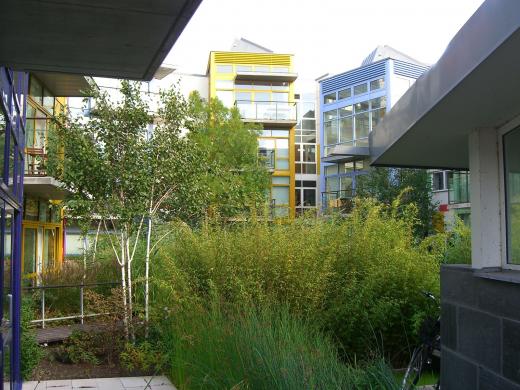 Western Harbour, Malmo, Sweden. This dense new urban neighborhood implements rain gardens, constructed wetlands and permeable paving. In addition to green infrastructure, Western Harbour uses an aquifer thermal energy storage system for year-round heating. Photo courtesy of nerdyplanner.blogspot.com.
Western Harbour, Malmo, Sweden. This dense new urban neighborhood implements rain gardens, constructed wetlands and permeable paving. In addition to green infrastructure, Western Harbour uses an aquifer thermal energy storage system for year-round heating. Photo courtesy of nerdyplanner.blogspot.com.
Permeable Paving
Permeable paving is designed to allow water to pass through it, preventing runoff associated with conventional pavement. It provides the structural support of conventional pavement, but is made up of a porous surface and an underlying aggregate layer. The aggregate layer provides temporary storage before the water infiltrates into the soil. Another type of permeable paving contains an aggregate layer and an underground pipe that routes stormwater to a collection system. The added underdrain is a “slow it” technology. There are many different types of porous surfaces including pervious asphalt, pervious concrete and interlocking pavers.
Where it works: parking lots, low-traffic streets, driveways, bike paths, patios, plaza and sidewalks
Advantages: reduces runoff volume and attenuates peak flows; improves water quality by reducing fine-grained sediment, organic matter and trace metals; reduces heat island effect (the phenomenon of urban areas retaining heat due to the prevalence of pavement)
Disadvantages: limited to paved areas with low traffic volumes and limited speeds; limited to slopes less than 5 percent; difficult in sites with compacted soils
Futuro office park, Liestal, Switzerland. This permeable parking strip drains to an adjacent grassy swale and helps protect water quality in the nearby creek during major storm events. Photo by Laura Tam.
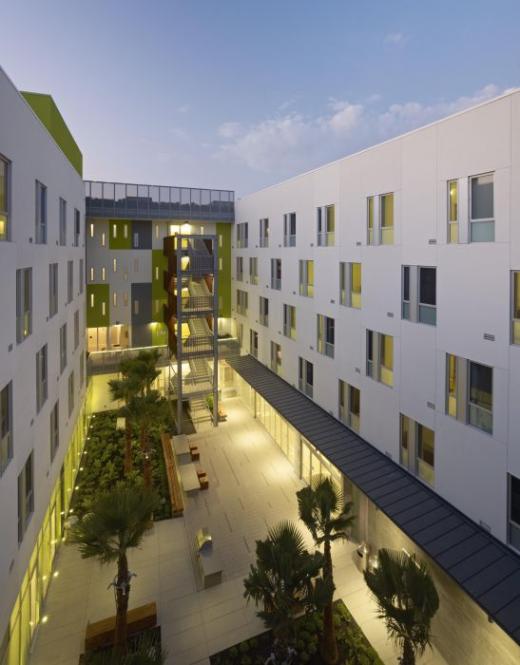 Julian and Raye Richardson Apartments, San Francisco, California. In this apartment building for formerly homeless residents, a central courtyard uses permeable paving over a gravel infiltration system and rain gardens for a responsive stormwater management system. Photo by Bruce Damonte courtesy of David Baker + Partners Architects.
Julian and Raye Richardson Apartments, San Francisco, California. In this apartment building for formerly homeless residents, a central courtyard uses permeable paving over a gravel infiltration system and rain gardens for a responsive stormwater management system. Photo by Bruce Damonte courtesy of David Baker + Partners Architects.
Slow It
Flow-through planter
These planters allow stormwater to flow and filter through vegetation, growing medium and gravel. They temporarily store stormwater runoff on top of the soil and filter sediment and pollutants as water infiltrates down through the planter. Planters do not infiltrate runoff into the ground, rather they rely on evapotranspiration (water uptake by plants) and short-term storage to manage stormwater.
Where it works: poorly drained sites; sites with contaminated soils; drainage from rooftop gutters; adjacent to streets where runoff may be directed into them for treatment
Advantages: planted vegetation helps lessen stormwater flows, traps sediments and reduces erosion; reduces stormwater volume and removes pollutants; provides water detention in significant rainfall events
Disadvantages: may require irrigation to maintain plants in the dry season
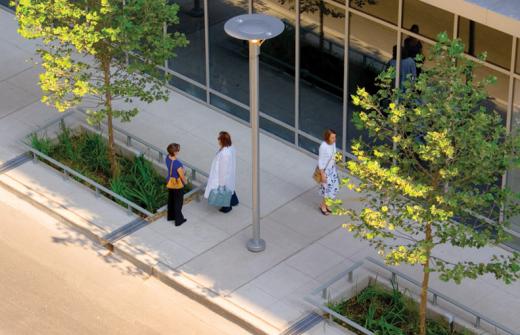 Rush University Medical Center, Chicago, Illinois. The medical center streetscape is lined with stormwater infiltration planters and includes drought-resistant plantings. The flow-through planters reduce urban runoff and minimize the need to irrigate street trees and vegetation. Photo courtesy of Hitchcock Design Group.
Rush University Medical Center, Chicago, Illinois. The medical center streetscape is lined with stormwater infiltration planters and includes drought-resistant plantings. The flow-through planters reduce urban runoff and minimize the need to irrigate street trees and vegetation. Photo courtesy of Hitchcock Design Group.
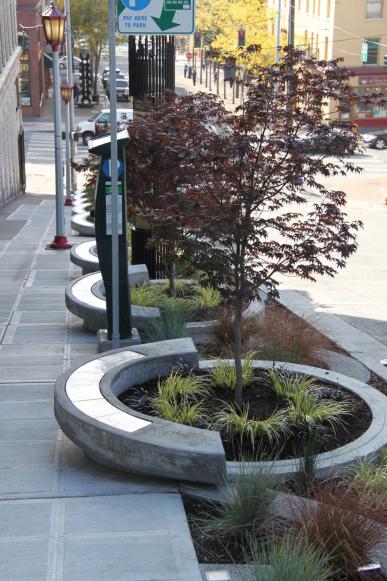
Maynard Avenue Green Street, Seattle, Washington. In these flow-through planters, runoff from the adjacent building roof cascades into a series of planters located along a steep sidewalk at 16 percent grade. The runoff from the roof slows down and irrigates the plants while adding seating for pedestrians. Photo courtesy of SvR Design.
Vegetated Roof
A vegetated roof, or green roof system, is composed of multiple layers including a waterproof membrane, subsurface drainage pipes, engineered planting soils and specially selected plants. Green roofs can be installed on many types of roofs, from small slanting roofs to large, flat commercial roofs. There are two basic types of green roofs: extensive and intensive. An extensive green roof system is a thin, lighter-weight system (usually less than 6 inches deep) planted predominantly with drought-tolerant succulent plants and grasses. An intensive green roof is deeper, often 18 inches, and can support plants that require great root depth.
Where it works: commercial, multifamily and industrial structures, as well as single-family homes, garages and sheds; can be used for new construction or to re-roof an existing building if there is sufficient structural support; roof slopes less than 5 degrees or greater than 20 degrees are not suitable
Advantages: reduces the volume and velocity of stormwater runoff from roofs by temporarily storing stormwater; provides added insulation and noise reduction compared to conventional roofs; reduces urban heat island effect and lowers temperature of stormwater runoff; increases biodiversity and habitat and provides aesthetic amenities
Disadvantages: limited to roof slopes less than 20 degrees; additional structural or seismic support may be needed to bear added weight; irrigation required to establish plants and maintain them during dry periods; high upfront cost compared to other green infrastructure
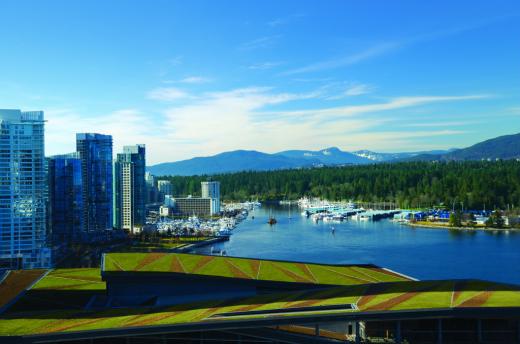 Vancouver Convention Centre, Vancouver, Canada. This 6-acre living roof is planted with 400,000 native plants and is inhabited by 240,000 bees. The living roof helps moderate extreme temperatures and infiltrates stormwater. An onsite wastewater treatment plant reduces the convention centre’s potable water usage by 73 percent. Photo courtesy of Vancouver Convention Centre.
Vancouver Convention Centre, Vancouver, Canada. This 6-acre living roof is planted with 400,000 native plants and is inhabited by 240,000 bees. The living roof helps moderate extreme temperatures and infiltrates stormwater. An onsite wastewater treatment plant reduces the convention centre’s potable water usage by 73 percent. Photo courtesy of Vancouver Convention Centre.
Constructed Wetland
These man-made wetlands are designed to reduce, detain and treat stormwater runoff. Water is stored in shallow vegetated pools that are designed to support wetland plants and simulate natural wetland ecosystems. Constructed wetlands have many of the same ecological functions as natural wetlands and are beneficial for flood control and water quality improvement.
Where it works: must be sited on relatively flat areas with less than 2 percent grade; can receive drainage from upstream slopes of up to 15 percent
Advantages: provides flood attenuation and reduces stormwater peak flows; highly effective at removing stormwater pollutants; provides valuable wetland habitat and community and aesthetic amenities; easily customizable for various sizes site conditions and budgets
Disadvantages: requires relatively large land area; requires periodic maintenance to ensure plant health and remove debris; if improperly designed, can become a mosquito breeding ground or drowning hazard
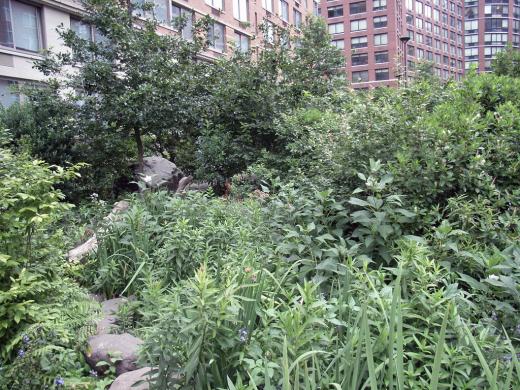 Teardrop Park, Battery Park City, New York. This constructed wetland infiltrates stormwater runoff from the entire park site and from several adjacent apartment buildings. Photo courtesy flickr user Payton Chung.
Teardrop Park, Battery Park City, New York. This constructed wetland infiltrates stormwater runoff from the entire park site and from several adjacent apartment buildings. Photo courtesy flickr user Payton Chung.
Detention Tank
A detention tank is an underground structure designed to briefly hold both wastewater and stormwater runoff during peak flows and then slowly release those flows for downstream treatment. The tanks can be used to alleviate localized flooding, while also lessening the demand on treatment facilities during storm events and decreasing the likelihood of downstream flooding and/or combined sewer discharges. The tanks are usually constructed out of concrete; the area above the tanks can be landscaped and used for other purposes, such as playgrounds or parking lots.
Where it works: requires open land, such as a parking lot, a street right of way or the basement of a new building
Advantages: provides high-volume storage protection against flooding; attenuates peak flows; good for sites where stormwater infiltration is not an option, such as those with contaminated urban soils
Disadvantages: limited in removing pollutants; subsurface stability is required for building underground structure; underground systems are expensive
Before:
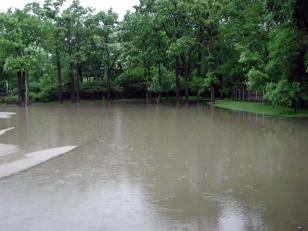
After:
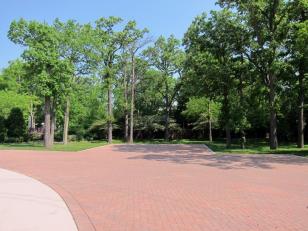
Ravinia Festival south parking lot, Highland Park, Illinois, before and after installation of a detention tank. The 1.3-acre parking lot was prone to flooding 25 days a year before the installation of the detention tank, reducing the parking capacity. The new parking lot contains 27,473 square feet of permeable concrete pavers, and the underground system holds 249,000 gallons of stormwater, releasing it slowly into the municipal storm sewer system. Forty-nine oak trees, threatened from inundation and compaction, were preserved as a result of this green infrastructure. Photos courtesy of Landscape Architecture Foundation.
Reuse It
Rainwater Harvesting
Rainwater harvesting is the collection and storage of stormwater runoff from impervious surfaces for later use in irrigation, toilet flushing or other non-potable uses. By temporarily holding stormwater runoff during a heavy rain, rain barrels and cisterns functionally add capacity to the city’s sewer system. However, they only serve as an effective stormwater control function if the stored water is used or emptied between most storms so that there is free storage volume for the next storm. Rain barrels are designed to overflow into the sewer system through the existing downspout connection in large storm events.
Where it works: above-ground storage must be sited in a stable, flat area; rainwater storage cannot block path of travel for fire safety access; overflow locations must be designed to direct flows away from building foundations and adjacent properties
Advantages: reduces volume and peak flows of stormwater entering the sewer; reduces energy and chemicals needed to treat stormwater; low maintenance for above ground cisterns; good for sites where infiltration is not an option; recycles water for non-potable reuse
Disadvantages: may require pumps or valves to use stored water; roof surfaces should not contain copper or materials treated with fungicides and herbicides if storing and reusing water for irrigation; prone to algal growth if placed in warm and sunny location; does not remove pollutants
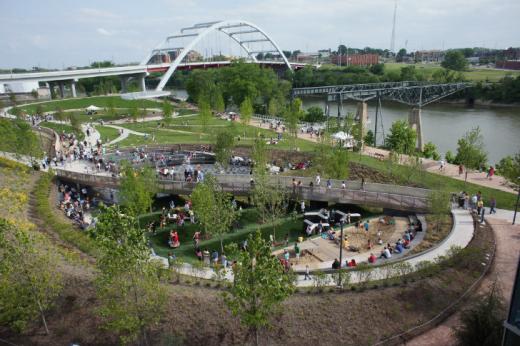 Cumberland Park, Nashville, Tennessee. This former riverfront wasteland was transformed into a riverfront family park. Each year 1,000,000 gallons of stormwater are captured and reused for irrigation. More than 1.6 acres of meadow and riparian grasses were restored. Photo © Hargreaves Associates.
Cumberland Park, Nashville, Tennessee. This former riverfront wasteland was transformed into a riverfront family park. Each year 1,000,000 gallons of stormwater are captured and reused for irrigation. More than 1.6 acres of meadow and riparian grasses were restored. Photo © Hargreaves Associates.
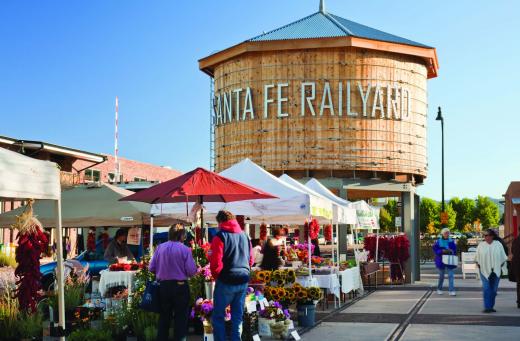 Santa Fe Railyard Park, Santa Fe, New Mexico. This urban park located in downtown Santa Fe uses a 40,000-gallon rainwater harvesting tank as the plaza’s focal point and includes the restoration of a historic acequia, a water conveyance channel. The tank collects rainwater from across the site for irrigation reuse. Photo © Peter Mauss/Esto. Project by Workshop: Ken Smith Landscape Architect.
Santa Fe Railyard Park, Santa Fe, New Mexico. This urban park located in downtown Santa Fe uses a 40,000-gallon rainwater harvesting tank as the plaza’s focal point and includes the restoration of a historic acequia, a water conveyance channel. The tank collects rainwater from across the site for irrigation reuse. Photo © Peter Mauss/Esto. Project by Workshop: Ken Smith Landscape Architect.
Move It
Creek Daylighting
Creek daylighting refers to uncovering and restoring natural creeks, streams and rivers that were previously buried in underground pipes or culverts, or otherwise removed from view. Daylighting historic creek channels can decrease demand on treatment facilities and enhance local neighborhoods.
Where it works: Well suited for historic creek paths that meander through existing open space or the public right-of-way
Advantages: provides flood attenuation and reduces stormwater peak flows; highly effective at removing stormwater pollutants and recharging groundwater; provides valuable habitat and community and aesthetic amenities
Disadvantages: High installation and maintenance costs; often requires land acquisition; area will not receive full benefits if only fragments of creek are day lit
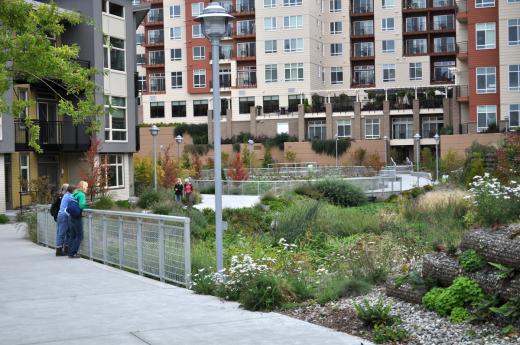 Thornton Creek, Seattle, Washington. Thornton Creek, a formerly covered creek within a mixed-use development area, treats runoff from 680 acres during small high-frequency storms. The restored creek contains cascading weirs, large woody debris and a riparian plant mix to contribute to urban habitat and biodiversity. Photo courtesy of SvR Design.
Thornton Creek, Seattle, Washington. Thornton Creek, a formerly covered creek within a mixed-use development area, treats runoff from 680 acres during small high-frequency storms. The restored creek contains cascading weirs, large woody debris and a riparian plant mix to contribute to urban habitat and biodiversity. Photo courtesy of SvR Design.
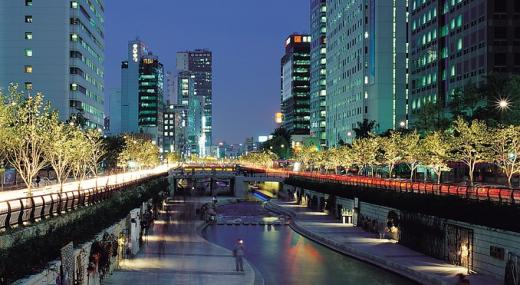 Cheonggyecheon Creek, Seoul, South Korea. This 100-acre, 3.6 mile long restoration project reclaims a natural creek that was buried underneath a freeway. The restoration provides flood protection for up to a 200-year flood event and increased biodiversity 639 percent between 2003 and 2008. The project reduces urban heat island effect and air pollution, and has increased bus ridership and land value within 150 feet of the restoration. Photo courtesy of Korea Tourism Organization.
Cheonggyecheon Creek, Seoul, South Korea. This 100-acre, 3.6 mile long restoration project reclaims a natural creek that was buried underneath a freeway. The restoration provides flood protection for up to a 200-year flood event and increased biodiversity 639 percent between 2003 and 2008. The project reduces urban heat island effect and air pollution, and has increased bus ridership and land value within 150 feet of the restoration. Photo courtesy of Korea Tourism Organization.
Read SPUR's post on the SF Sewer System Improvement Program >>
